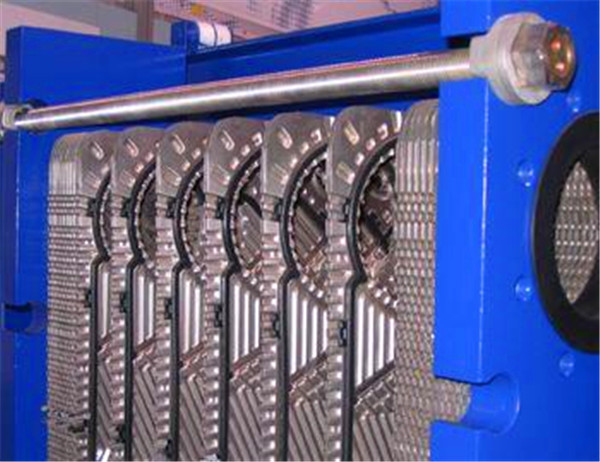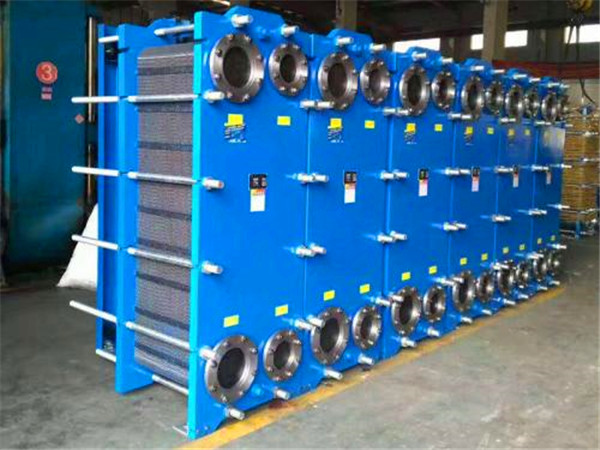Science Today: How to clean a plate heat exchanger
Keeping the plate clean is one of the important conditions for maintaining a high heat transfer coefficient. Between the plates, the medium is moving along a narrow winding flow, and even without too thick a layer of scale, it can cause changes in the flow channel that significantly affect the movement of the fluid, leading to an increase in pressure drop and a decrease in the heat transfer coefficient, as in the case of the heated plate heat exchangers used in sugar mills, where the secondary water is not well treated and the ports become clogged after only two months of use and cannot continue to operate.

1. Chemical cleaning methods
This method allows the chemical solution to circulate through a heat exchanger to dissolve and expel dirt from the plate surface. This method eliminates the need to separate heat exchangers, simplifying the cleaning process and reducing cleaning labor. Chemical cleaning is an ideal method because corrugated plates clean turbulent liquids and help dissolve scale.
2. Mechanical (physical) cleaning methods
This method involves manual cleaning behind the board with a brush to remove dirt from the surface of the board. While this method is more direct, it is not easy to clean for harder, thicker layers of dirt.
3. Integrated cleaning methods
Because the layer of dirt is hard and thick, it is difficult to clean simply using one of the above methods. The combined method is to soften the oxide layer by chemical cleaning and then remove the oxide layer by mechanical (physical) cleaning to keep the plate clean.
4. Precautions during the cleaning process
(1) Chemical cleaning plate heat exchanger solution to maintain the flow rate, generally 0.8 ~ 1.2m/s. The purpose is to increase the turbulence in the solution.
(2) Different chemical cleaning solutions should be used for different kinds of dirt. In addition to the usual dilute soda solution, a 5% nitric acid solution can be used for scale, and a 5% hydrochloric acid solution can be used to produce pure soda. But the chemical wash that corrodes the dish should not be used.
(3) Mechanical (physical) cleaning is not allowed to scrub the stainless steel plate with a carbon steel brush to avoid accelerating the corrosion of the plate. At the same time, the board surface cannot be scratched, deformed, etc.
(4) The cleaned plate should be washed and dried with water, and the plate should be placed to prevent deformation.
Installation and application of plate heat exchangers: Plate heat exchangers are divided into two types of installation depending on the availability of saddle support. First, for plate heat exchangers without saddle brackets, the heat exchanger should be installed on the saddle base of the brick, the installed plate heat exchanger does not need to be fixed with the base at this time, the whole plate can move freely with the expansion changes. Secondly, when replacing the saddle plate, tile concrete should be laid on the foundation first, and when the saddle and ground concrete are completely dry, the ground foot bolts will fix the saddle and ground concrete completely. During the installation of the plate heat exchanger, sufficient space should be left for maintenance and cleaning. The heat exchanger shall not be operated in excess of the conditions specified in the nameplate. The temperature and pressure of the heat exchanger media should be checked and analyzed to prevent abnormal operation of the heat exchanger. The heat transfer effect of the heat exchanger is very much related to the scale, the larger the scale, the less satisfactory the heat transfer effect. Therefore, the limescale on the heat exchanger plate should be cleaned in time. This prevents excessive scaling from affecting heat transfer.

The above is the content provided by Ruipute to share about how the plate heat exchanger plate should be cleaned and maintained, hope it can help you. If you know more about plate heat exchangers, please don't hesitate to contact us.
Related information
- As a manufacturer of Plates and Gaskets, what are the advantages of Qingdao Ruipute Heat Exchange Equipment Manufacturing Co., Ltd ?
- What you need to pay attention to for the installation of Ruipute plate heat exchanger
- How to deal with the plate heat exchanger heat supply insufficient problem?
- Methods of reducing electrochemical corrosion of plate heat exchanger
- Working condition production line with large particle? Wide channel plate heat exchanger can be perfectly solved
- Difficulties in the design and application of semi-welded plate heat exchangers, an article will let you understand thoroughly
Relevant article
- 1
- Can plate heat exchanger be directly used for feed water heating or cooling?
- Why the heat transfer efficiency of plate heat exchangers in the heating industry is low
- How to determine the size and angle of plate heat exchanger plate?
- What is the proportion of pressure drop in the selection of plate heat exchanger?
- Why do we recommend food grade plate heat exchanger for beer brewing and fermentation? What should we pay attention to?
- What is the difference between the hanging holes on the plate of plate heat exchanger?
- What are the applications of plate and shell heat exchanger in the field of petroleum refining
- What is the key to the manufacture of plate heat exchangers with small temperature differences?
- How to descale the plate heat exchanger? What problems should be paid attention to during use?
Latest information
- Heat station supporting plate heat exchanger installation is a technical work, these points should be noted
- Sulfuric acid and other corrosive media for industrial plate heat exchanger requirements are what
- Simple and effective chemical cleaning method of coal chemical plate heat exchanger, can effectively improve efficiency
- A high-quality petrochemical plate heat exchanger in the production of what to consider
- These causes of chemical plate heat exchanger gasket aging you may not know
- Chemical plant plate heat exchanger, sulfuric acid cooling needs attention
- High-end plate heat exchanger customization, specifically for your special working conditions
- The working principle of gasket type industrial plate heat exchanger and the scenarios of its use are worth knowing in depth
- Still worrying about the wholesale price of industrial plate heat exchangers? An article to make you no longer tangled
- The original lubricant in the chemical plate heat exchanger plays so many roles!








